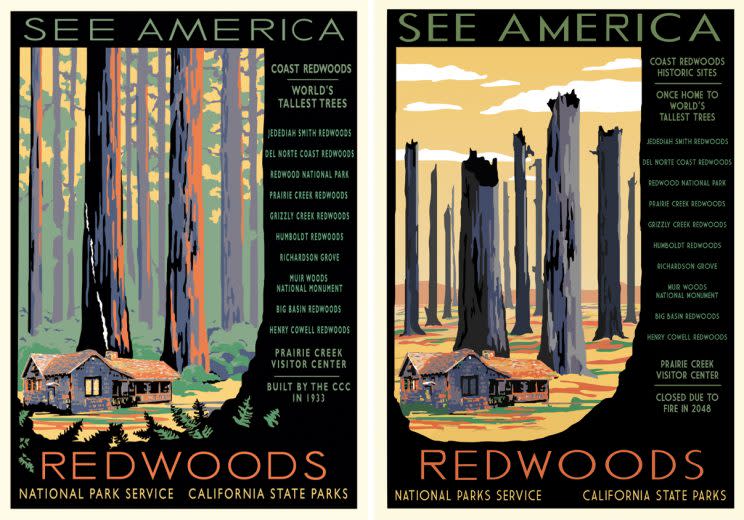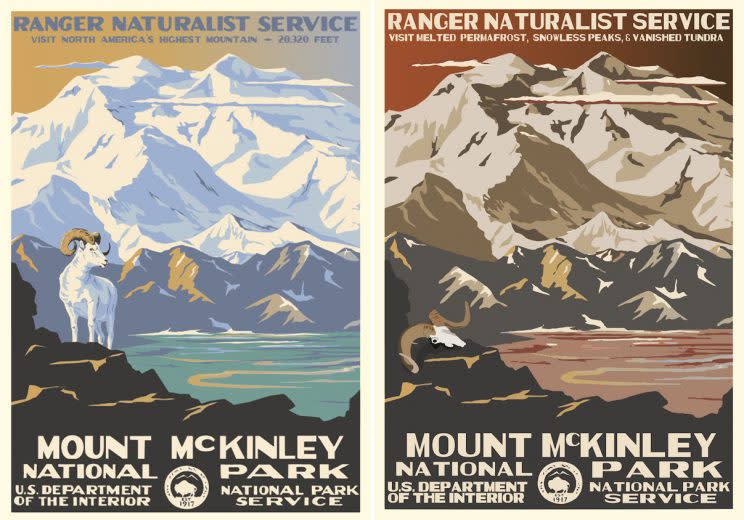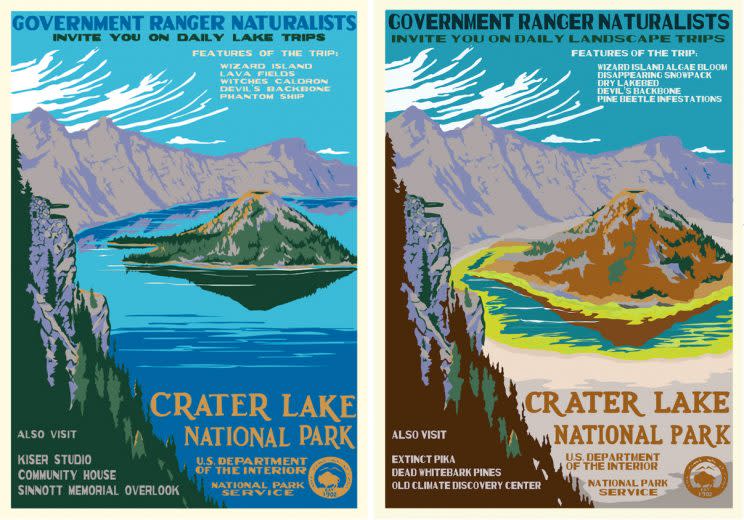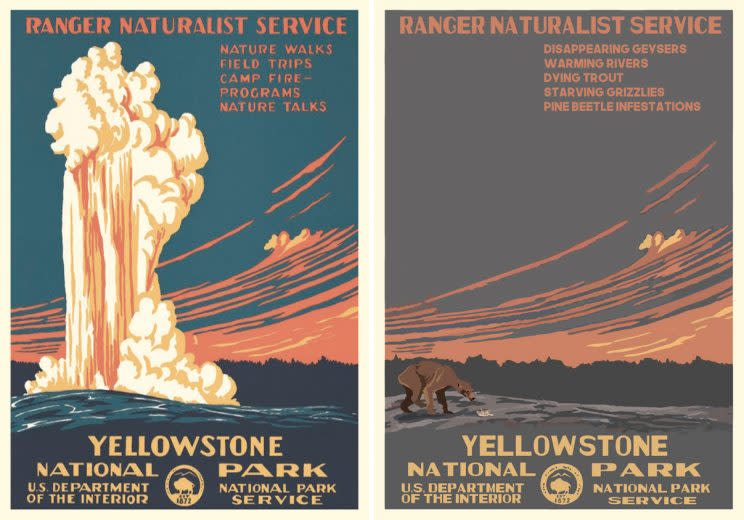National parks in 2050: WPA-style posters warn of a dreary future from climate change

A California artist is putting her own touch on classic national park travel posters to show what might happen to the U.S.’s treasures if climate change continues unabated.
Hannah Rothstein, of Berkeley, Calif., hopes her series of paintings and poster-size prints, “National Parks 2050,” will spark Americans to take action upon seeing climate change hit so close to home. The paintings depict dead redwoods, dried-up lakes, desiccated saguaro cactuses and snowless mountains.
Her message is that the U.S. can stave this off, but only by acting now — embracing the innovation and can-do spirit that made the country great.
Yahoo News reached out to Rothstein to learn more about what motivated the project and what she hopes will come from it. She said that climate change should be considered a nonpartisan issue and hopes that Americans of all political persuasions — from politicians on Capitol Hill to everyday citizens across the country — can work together to save the national parks and the world from the fate she depicts.

The following conversation has been edited for clarity and length.
Yahoo News: How did you decide to address climate change with your artwork?
Hannah Rothstein: Climate change is an issue that worries me quite a bit, particularly in the current political climate. I’m afraid that any progress we have made is being infringed upon, and it’s not an issue where we can afford to go backward. If we don’t start making the positive changes we can make now, we can’t exactly reverse what we’re about to do. And I’m scared about what the future might look like, both as someone who needs the resources we depend upon in this world and as someone who loves the outdoors. So it’s an issue I knew I wanted to address in my art, and it’s been on my mind. I spent about a month or so thinking about it before I came up with an idea that felt right.
Would you consider these prints political or would you choose another word to define them?
I’m trying to keep this a nonpartisan art project. I know that climate change is often politicized, but it really is a nonpartisan issue. It’s something that’s going to affect us all, whether we are on the far left, far right or somewhere above or below the spectrum of political belief. It’s something that is really going to have an extreme impact on all of our lives. So I would more so call it a humanist art project. I definitely understand why it feels political because unfortunately this issue is politicized right now, but I want people to remember that it’s not. Even with the choices of the parks that I decided to feature in the project, I tried to choose parks that represented a diversity of both location and political persuasion. There are parks from red states. There are parks from blue states. I tried hard to do that deliberately.

What sort of research went into determining what the parks might look like if we stay on our current trajectory?
I looked at three main spots. Each park has a dot-gov website, and most have information about how climate change is currently affecting the park and how it’s projected to affect the park in the future. I read through each park’s site. Some of them even have YouTube videos with rangers talking about it. I looked at news articles from reputable news sources, often based off scientific studies. And then I’d follow through by looking at those studies and others.
What were some interesting things you learned while doing the research about the effects that you incorporated into the artwork?
Some of the things that maybe were a little less obvious that I found to be fascinating were the starving grizzlies in the Yosemite posters. That’s in part because the pine trees are being threatened by the warming of the climate, which in turn promotes pine beetle infestation. Pine beetles are killing off pine trees with greater and greater frequency, and grizzly bears eat a lot of pine nuts for their food. That’s something I found fascinating on a personal level. I was in Yosemite in March and saw that about 30 percent of the pine trees are brown. At that point I could look at them and say, “This is likely because of the pine beetle infestations that are happening.” And that’s something I wouldn’t have known before. Seeing that live and in-action was very impactful and meaningful to me.

Another thing I found interesting I couldn’t quite include in the poster because I was trying to keep concise: In the Yellowstone area there’s going to be less snowmelt, and that’s what’s going to result in the geysers erupting less often, because there’s less groundwater. Less snowmelt and groundwater also means there’s going to be less water going into the Colorado River, a major source of water for agricultural purposes. So it’s really going to affect people’s food in the near future. It’s fascinating to think about how that will have a real, immediate effect on people’s lives.
What kind of feedback have you gotten?
Mostly very positive, and I’ve been happy to see how meaningful people find it. I think the general sentiment is that this is depressing but really impactful and important. I’m hoping that it inspires people to take action even though it is a little bit on the sadder side. I hope it helps people remember this is not an issue we can wait on and that’s it’s hitting close to home. It’s in all of our backyards. There have, of course, been some comments on online articles about how “climate change is not happening.” One person commented that I was “a liberal idiot artist,” which I think means I was a success. I’m not trying to politicize it, but that did amuse me. Mostly the feedback has been really great.
These are homages to the original national park posters. Could you tell me a little bit about the origin of those?
That’s actually an interesting thing that I learned a lot about during this process as well. WPA [the Works Progress Administration] offered this service to the parks. There were around 14 original posters designed by the WPA artists and screenprinted in the ‘30s and ‘40s. This guy, Ranger Doug, became really interested in these posters and started working with the parks to do contemporary re-creations in the old style to make them for even more parks. He’s done about 35, so it makes about 50 in total. I find these posters very evocative of a time we’re all nostalgic for, when America was at its greatest, building and creating. I think bringing that sentiment to help convey that message makes it all the more meaningful and impactful.
You can see more of Hannah Rothstein’s work on her official website, where she’s selling limited-edition “National Parks 2050″ prints. She said a portion of proceeds will go to climate-focused organizations.
Read more from Yahoo News:



